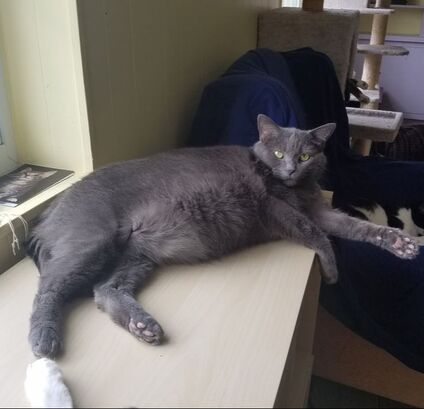Obesity in Cats

Every day, statistics about the obesity crisis in America are plastered all over the news. The effects of being overweight and obese are well known, but how often do you hear about the obesity crisis with companion animals?
According to a 2018 survey done by the Association for Pet Obesity Prevention, 59.5% of cats are now estimated to be clinically overweight. Of course, just like with people, every cat has a different ideal weight. To determine if your pet is overweight or obese, it is best to discuss the issue with your veterinarian. It if is determined that your pet is overweight, the veterinarian can then give you an ideal weight range as well as diet advice.
Problem
Obesity can cause a wide range of health issues in cats including:
Treatment
Veterinarians will often suggest a change in diet to help your cat lose weight. A diet change could include going from a “free-feeding” set-up (where food is always left out) to a scheduled feeding time. This allows the cat guardian to portion out the food and prevents overeating. Guardians can also switch to wet food which has more protein and a higher water content. As with humans, you should always discuss a diet plan for your cat with a professional before changing their food.
Another treatment is to get your cat active and exercising. It is very important to make sure that your cat is getting plenty of play time. Just putting toys out is often not enough. Interactive play is crucial. One of the first things that you can do is to figure out what kinds of toys get your cat ready and meowing to play! If your cat is excited about the toy, it is easier to get them to play. Read our tips on entertaining an indoor cat here to learn how you can get your cat active and playful.
It is important to remember that although fat cats may look cute and cuddly, they are at a greater risk of severe aliments. Managing your cat’s weight should be taken seriously and should be done with the advice of a veterinary throughout the process.
References
Obesity in Cats and How to Put a Cat on a Diet. (n.d.). Retrieved from
https://www.petmd.com/cat/nutrition/evr_ct_obesity_in_cats_and_what_to_do_about_an_overweight_cat
Obesity. (n.d.). Retrieved from https://www2.vet.cornell.edu/departments-centers-and-institutes/cornell-feline-health-center/health-information/feline-health-topics/obesity
Obesity in Cats. Retrieved from http://www.vetstreet.com/care/obesity-in-cats
According to a 2018 survey done by the Association for Pet Obesity Prevention, 59.5% of cats are now estimated to be clinically overweight. Of course, just like with people, every cat has a different ideal weight. To determine if your pet is overweight or obese, it is best to discuss the issue with your veterinarian. It if is determined that your pet is overweight, the veterinarian can then give you an ideal weight range as well as diet advice.
Problem
Obesity can cause a wide range of health issues in cats including:
- Joint problems such as arthritis
- Heart disease
- Labored breathing
- Diabetes
- High blood pressure
- Hepatic lipidosis (severe form of liver failure)
Treatment
Veterinarians will often suggest a change in diet to help your cat lose weight. A diet change could include going from a “free-feeding” set-up (where food is always left out) to a scheduled feeding time. This allows the cat guardian to portion out the food and prevents overeating. Guardians can also switch to wet food which has more protein and a higher water content. As with humans, you should always discuss a diet plan for your cat with a professional before changing their food.
Another treatment is to get your cat active and exercising. It is very important to make sure that your cat is getting plenty of play time. Just putting toys out is often not enough. Interactive play is crucial. One of the first things that you can do is to figure out what kinds of toys get your cat ready and meowing to play! If your cat is excited about the toy, it is easier to get them to play. Read our tips on entertaining an indoor cat here to learn how you can get your cat active and playful.
It is important to remember that although fat cats may look cute and cuddly, they are at a greater risk of severe aliments. Managing your cat’s weight should be taken seriously and should be done with the advice of a veterinary throughout the process.
References
Obesity in Cats and How to Put a Cat on a Diet. (n.d.). Retrieved from
https://www.petmd.com/cat/nutrition/evr_ct_obesity_in_cats_and_what_to_do_about_an_overweight_cat
Obesity. (n.d.). Retrieved from https://www2.vet.cornell.edu/departments-centers-and-institutes/cornell-feline-health-center/health-information/feline-health-topics/obesity
Obesity in Cats. Retrieved from http://www.vetstreet.com/care/obesity-in-cats